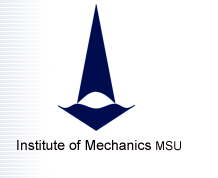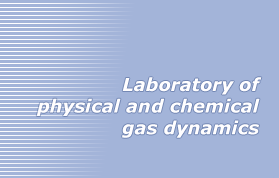 |

|
HISTORY
In 1964 at the Institute of Mechanics of Lomonosov Moscow State University the laboratory of physical-chemical gasdynamics had been set up under the supervision of Tirskiy G.A., which employed a team of three scientists - Tirskiy G.A., Gershbein E.A., Suslov O.N.; before they worked in the general hydromechanics division.
Over the years, there worked the following scientists at the laboratory: Apshtein E.Z., Brykina I.G., Gershbein E.A., Glazkov Yu.V., Egorova L.A., Efimova L.G., Kovalev V.L., Krupnov A.A., Lebedeva L.L., Lokhin V.V., Sakharov V.I., Suslov O.N., Titov O.V., Fateeva E.I., Khanukaeva D.Y., Shcherbak, V.G., as well as postgraduate and graduate students and scientists researchers of Lomonosov Moscow State University, Moscow Institute of Physics and Technology, and Tomsk State University.
At the present time there are three Grand PhD Doctor of Science and one Candidate of Science (PhD) at the laboratory.

FIELDS OF SCIENTIFIC RESEARCHES:
- physical-chemical gasdynamics, hypersonic aerodynamics
- heat and mass transfer;
- kinetic theory of gases;
- thermodynamics of irreversible processes;
- computational fluid dynamics;
- aerothermoballistics and destruction of meteoroids in the atmosphere.
MAIN SCIENTIFIC ACHIEVEMENTS
- The foundation had been laid down for a new scientific field – the theory of thermo-chemical destruction of thermal-protective coating of spacecrafts entering into atmosphere of the Earth and other planets with hypersonic velocities under the influence of convective and radiative heat fluxes and aerodynamic forces.
- Mass loss of the thermal protection of spacecraft "Lunnik" on entering the Earth's atmosphere after fly-around the Moon in 1968 had been predicted.
- The technique had been developed for calculating destruction of melting vitreous bodies in hypersonic gas flows taking into account the internal radiative transfer. Mass loss and shape change had been studied when they entering into atmospheres of planets.
- The general "area rule" had been discovered for radiative heat flux, the ablation rate and drag of ablative bodies. Subsequently this rule had been extended to integrated quantities of different physical nature (attached mass of bodies in an incompressible ideal fluid; membrane free frequencies; the areas covered by the explosion shock wave in an inhomogeneous atmosphere, etc.).
- The problem of aerothermoballistics of spacecraft had been first formulated and solved when the equations of radiation aerodynamics and heat and mass transfer must be solved together with the ballistics equations for variable-shape body.
- In the gas kinetic theory the opportune for solving system of mass and energy conservation equations had been obtained for a multicomponent, multitemperature gas mixture and plasma where possible electromagnetic field.
- The accurate formulation of the problem of multicomponent gas flow with different diffusion properties of components had been given. This had made it possible to discover the effect of separation of chemical elements due to selectivity of surface catalycity influence on the recombination of atoms. It had been shown that on chemically neutral surface diffusion separation of elements can be caused by the difference in the rates of homogeneous chemical reactions.
- The hydrodynamic equations for the thermo-chemically equilibrium flows of multicomponent gas and plasma with different diffusion properties of components had been derived and accurate expressions for all effective transport coefficients had been given.
- The problem of flow in the chemically non-equilibrium boundary layer at a stagnation point of blunt body had been solved by the asymptotic method and formulas for the heat and diffusion fluxes to a surface of any catalycity had been obtained.
- Multicomponent 2D and 3D gas flows in a laminar boundary layer and in a hypersonic viscous shock layer had been studied by asymptotic and numerical methods, including flows with intense injection or suction at the surface.
- The phenomenological theory of catalytic reactions on reusable thermal-protective coating had been developed which is based on analysis of elementary physical-chemical processes on the surface in the partially dissociated and ionized air flow. The dependence of the coefficients of heterogeneous recombination on surface conditions (pressure, temperature and concentration of components) had been elucidated.
- Ñalculation of heat transfer of reentry space vehicles had been carried out within the framework of continuum equations taking into account the non-equilibrium thermo-chemical kinetics, i.e. taking into account the self-consistent vibration-dissociation and electron-ionization interactions in the reactions in the shock layer.
- The continuum flow models had been developed which can be used for heat transfer and shear stress prediction in problems of hypersonic rarefied gas flow over bodies in the transitional from free-molecular to continuum flow regime.
- The theory of simulation of processes and flow of thermally and chemically nonequilibrium gas in HF plasmatron IPG-4 (IPM RAS) and WT VAT-104 (TsAGI) in the framework of the Navier-Stokes and Maxwell equations had been developed.
- The unique approximate analytical and numerical methods for calculation of 3D supersonic and hypersonic viscous flows over bodies had been proposed, for example, the integral methods of successive approximations. The analytical solutions of 2D and 3D perfect gas laminar flows over bodies for all Reynolds numbers had been obtained.
- Simple formulas for the heat flux on a fully catalytic surface of blunt bodies in 2D and 3D chemically reacting gas flows at high and moderate Reynolds numbers had been obtained.
- The method of similarity of three-dimensional and axisymmetric flows had been developed for the heat transfer and skin friction calculation on blunt bodies, which converts 3D hypersonic flow problem to axisymmetric one. Similarity method is applicable for various viscous flow models – Navier–Stokes equations, full and thin viscous shock layer, boundary layer – for homogeneous gas flow as well as for chemically nonequilibrium multicomponent gas flow for different wall catalytic properties.
- The problem of mass loss and wake luminosity of small meteoroids, moving in rarefied layers of atmospheres of the Earth, Mars and Venus had been formulated and solved.
- The general dependence for radiative heat flux to a surface of axisymmetric and 3D bodies had been found out by the numerical study of a supersonic radiating gas flow.
- A theory of interaction of large meteoroids with the Earth's atmosphere had been developed when meteorite shower and "explosion" of meteoroids are arisen. The two-stage model of destruction, explaining luminosity, or "explosion" (fast transfer of kinetic energy of meteoroid to atmosphere), of fireballs in the Earth's atmosphere had been proposed.
- New results in the theory of symmetry, the theory of nonlinear tensor functions, the general theory of models of continuum with complicate physical-chemical properties, continuum electrodynamics and the theory of models of relativistic continuum interacting with the electromagnetic field had been obtained.
- To solve the problems of hypersonic flow around bodies the original and effective numerical methods has been developed:
- Finite-difference methods of high-order accuracy with respect to the normal coordinate for solving nonequilibrium multicomponent boundary layer equations and viscous shock layer equations;
- Global iterations method for solving two-dimensional steady Euler equations, viscous shock layer and parabolized Navier–Stokes equations;
- Finite-difference methods of high-order accuracy for solving the Euler and Navier–Stokes equations.
To solve the problems of hypersonic flow around bodies the original and effective numerical methods has been developed:
- Finite-difference methods of high-order accuracy with respect to the normal coordinate for solving nonequilibrium multicomponent boundary layer equations and viscous shock layer equations;
- Global iterations method for solving two-dimensional steady Euler equations, viscous shock layer and parabolized Navier–Stokes equations;
- Finite-difference methods of high-order accuracy for solving the Euler and Navier–Stokes equations.
At the laboratory 19 PhD and 5 Grand PhD theses had been defended.
Laboratory scientists published more than 500 papers in national and international scientific journals, five books, they made more than 400 presentations in national and international conferences, symposia, seminars and scientific schools. There are invention patents.
Laboratory scientists do an educational work: guide the steps of postgraduate and graduate students in their studies, give lectures and seminars at Lomonosov Moscow State University and Moscow Institute of Physics and Technology.
|  |















